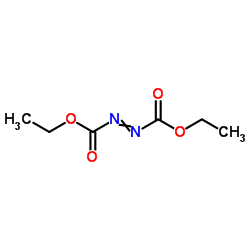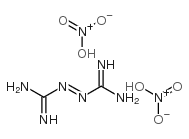Azodicarbonamide

Azodicarbonamide structure
|
Common Name | Azodicarbonamide | ||
|---|---|---|---|---|
| CAS Number | 123-77-3 | Molecular Weight | 116.079 | |
| Density | 1.9±0.1 g/cm3 | Boiling Point | 241.3±23.0 °C at 760 mmHg | |
| Molecular Formula | C2H4N4O2 | Melting Point | 220-225 °C (dec.)(lit.) | |
| MSDS | Chinese USA | Flash Point | 99.7±22.6 °C | |
| Symbol |

GHS08 |
Signal Word | Danger | |
| Name | Azodicarbonamide |
|---|---|
| Synonym | More Synonyms |
| Density | 1.9±0.1 g/cm3 |
|---|---|
| Boiling Point | 241.3±23.0 °C at 760 mmHg |
| Melting Point | 220-225 °C (dec.)(lit.) |
| Molecular Formula | C2H4N4O2 |
| Molecular Weight | 116.079 |
| Flash Point | 99.7±22.6 °C |
| Exact Mass | 116.033424 |
| PSA | 110.90000 |
| LogP | -0.85 |
| Vapour Pressure | 0.0±1.1 mmHg at 25°C |
| Index of Refraction | 1.680 |
| Stability | Highly flammable. Incompatible with strong oxidizing agents, strong acids, strong bases, heavy metal salts. |
| Water Solubility | SOLUBLE IN HOT WATER |
CHEMICAL IDENTIFICATION
HEALTH HAZARD DATAACUTE TOXICITY DATA
MUTATION DATA
|
| Symbol |

GHS08 |
|---|---|
| Signal Word | Danger |
| Hazard Statements | H334 |
| Supplemental HS | Risk of explosion if heated under confinement. |
| Precautionary Statements | P261-P284-P304 + P340-P342 + P311 |
| Personal Protective Equipment | dust mask type N95 (US);Eyeshields;Faceshields;Gloves |
| Hazard Codes | Xn:Harmful |
| Risk Phrases | R42;R44 |
| Safety Phrases | S22-S24-S37 |
| RIDADR | UN 3242 4.1/PG 2 |
| WGK Germany | 1 |
| RTECS | LQ1040000 |
| Packaging Group | II |
| Hazard Class | 4.1 |
| HS Code | 2924199090 |
|
~77% 
Azodicarbonamide CAS#:123-77-3 |
| Literature: Islamgulova; Shitova; Tomilov; Pilyugin; Maslennikov Russian Journal of Applied Chemistry, 1998 , vol. 71, # 7 p. 1176 - 1180 |
|
~% 
Azodicarbonamide CAS#:123-77-3 |
| Literature: Journal of the American Chemical Society, , vol. 92, p. 2096 - 2100 |
|
~% 
Azodicarbonamide CAS#:123-77-3 |
| Literature: Journal fuer Praktische Chemie (Leipzig), , vol. <2>52, p. 480 |
|
~% 
Azodicarbonamide CAS#:123-77-3
Detail
|
| Literature: Chemische Berichte, , vol. 122, p. 745 - 748 |
|
~% 
Azodicarbonamide CAS#:123-77-3 |
| Literature: Justus Liebigs Annalen der Chemie, , vol. 270, p. 44 Justus Liebigs Annalen der Chemie, , vol. 271, p. 129 |
| Precursor 5 | |
|---|---|
| DownStream 9 | |
| HS Code | 2927000090 |
|---|---|
| Summary | 2927000090 other diazo-, azo- or azoxy-compounds。Supervision conditions:None。VAT:17.0%。Tax rebate rate:9.0%。MFN tariff:6.5%。General tariff:30.0% |
|
Anti-HIV agents that selectively target retroviral nucleocapsid protein zinc fingers without affecting cellular zinc finger proteins.
J. Med. Chem. 41(9) , 1371-81, (1998) Agents that target the two highly conserved Zn fingers of the human immunodeficiency virus (HIV) nucleocapsid p7 (NCp7) protein are under development as antivirals. These agents covalently modify Zn-c... |
|
|
Assessment of the determination of azodicarbonamide and its decomposition product semicarbazide: investigation of variation in flour and flour products.
J. Agric. Food Chem. 59(17) , 9313-8, (2011) Azodicarbonamide, as a bleaching agent and improving agent, is a permitted food additive in certain countries and can be determined by high-performance liquid chromatography. However, it partially deg... |
|
|
Comparative studies by IR, Raman, and surface-enhanced Raman spectroscopy of azodicarbonamide, biurea and semicarbazide hydrochloride.
Spectrochim. Acta. A. Mol. Biomol. Spectrosc. 114 , 80-4, (2013) Azodicarbonamide is widely applied in the food industry as a new flour gluten fortifier in China, Canada, the United States, and some other countries, whose metabolites of biurea and semicarbazide hyd... |
| Carbamoyliminourea |
| Diazene-1,2-dicarboxamide |
| (E)-carbamoyliminourea |
| MFCD00007958 |
| EINECS 204-650-8 |







 CAS#:598-94-7
CAS#:598-94-7 CAS#:420-05-3
CAS#:420-05-3 CAS#:201230-82-2
CAS#:201230-82-2 CAS#:7664-41-7
CAS#:7664-41-7 CAS#:10396-10-8
CAS#:10396-10-8 CAS#:74-90-8
CAS#:74-90-8 CAS#:7732-18-5
CAS#:7732-18-5 CAS#:4910-62-7
CAS#:4910-62-7